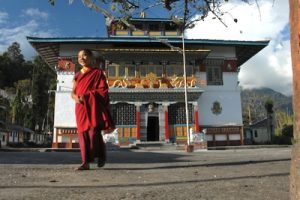TOURS in SIKKIM and DARJEELING
TOURS in SIKKIM and DARJEELING
About the Tours in Sikkim
Sikkim lies wedged in between Nepal and Bhutan and shares its northern border with Tibet (China). Like Nepal and Bhutan, Sikkim’s geographical position can be described as a slice of the Himalaya, covering the area south of the highest peaks. Earlier, Sikkim was a small independent kingdom, like Nepal and Bhutan. Later it became a ‘princely state’ under British India and an Indian protectorate after Indian independence. In 1975 it joined India as its smallest state.
Sikkim is known for its biodiversity, which is largely due to the enormous range of climates – from subtropical to alpine – as well as the prudent policies of its state government, which has embraced sustainable development already a long tie ago. Polythene bags are forbidden throughout the state, the use of plastic bottles is being phased out and dumping of garbage in Gangtok attracts hefty fines, just to name a few of its accomplishments.
Read more…Read less…In the south, where Sikkim borders the Darjeeling district of NW-Bengal, the barely 200m high siwaliks (Himalayan foothills) are covered in dense topical jungle where elephants and tigers roam. From there, traveling north means traveling up. More, and even denser, forests line the road, interspersed with enclaves of agricultural land where cardamom, rice, maize, buckwheat and millet grow, along with nearly every spice or vegetable that you can think of. Deep ravines have been cut out by thundering mountain streams such as the Teesta River, which can be termed the ‘wet dream’ of both hydro-electrical engineers and rafter’s.
Gangtok, Sikkim’s capital, sits at a relatively modest height of 1650m amidst what can be termed the heartland of Sikkim. Here, the major portion of the multi-ethnic population lives. People originally hailing from Nepal – belonging to a range of tribes such as Rai , Newaris, Sherpas and Tamangs – form the majority. They live peacefully together with the original inhabitants of Sikkim, the Lepchas, and the Bhutias who immigrated from Tibet in the seventeenth century. North of Gangtok lie the isolated valleys of Lachung and Lachen. Exclusively inhabited by Bhutias, who follow the ’Tibetan’ Mahayana form of Buddhism.
For the traveler, Sikkim (and Darjeeling’s) main claim to fame, might very well be the Kangchenjunga, world’s third tallest mountain at 8586m. This phenomenal Himalayan giant, as well as smaller siblings, can be seen from many places in Sikkim, from Darjeeling and the treks to skirt the border with Nepal.
Thanks to Sikkim and Darjeeling’s huge range of altitudes and landscapes, the traveler has a lot to choose from. We can offer car-based tours with or without day walks in the ‘monastery circuit’ of West Sikkim or take you to the high valleys of Lachung and Lachen in the North. For trekkers, there are a number of easy to moderately strenuous treks that stay well below 2500m. They lead through green farmland, bamboo groves and subtropical forests full of orchids, and along tiny villages, picturesque Hindu temples and Buddhist monasteries. Overnight stay is in tents or in clean and cosy home-stays.
Among the medium-level treks, the Singalila Ridge trek (in Darjeeling District) is justifiably popular as it is not very hard but offers awesome views of Mt. Kangchenjunga and other eight thousanders in Nepal. A bit higher up inside Sikkim, a similar trek can be done as a prelude to the Kangchenjunga trek. The latter is arguably the mother of all treks in Sikkim. This 8-day trek starts at Yuksom (1740 m/ 5700 ft) and gradually climbs through rhododendron forests and alpine yak meadows to the pass Goecha La (4940 m/16207 ft). Here, you get awesome views of the glacier-clad Kangchenjunga.
Jeep Tours
Treks & walking Tours
Mountain Bike Tours
Short Stays
ABOUT Sikkim
 Sikkim and neighboring Darjeeling have a lot to offer to mountain lovers, aficionados of Buddhist culture and trekkers. Darjeeling, the former summer capital of British India has a unique old-world charm and boasts great views from many hotel windows. It’s next-door neighbor Sikkim – of which it used to be part – is a gem of cultural and natural diversity. Until 1974 an independent kingdom, it is part of India now. It is home to people of very different cultures, most from Nepali descent or originating from Tibetan and Bhutan, such as the Bhutias who brought Buddhism to the area four centuries ago. Thanks to them Sikkim boasts of colorful gompas, Buddhist monasteries and Buddhist festivals (tsechus) where monks dressed up as ‘gods’, demons and celestial beings enact the success story of Buddhism’s spread over the Himalayas in the early Middle Ages. The Lepcha’s, until recent forest-dwelling animists, hold a unique culture that the Sikkimese government is trying to preserve.
Sikkim’s mountains range from 200 m to 8586 m and walkers and trekkers can choose from jungle treks, low altitude village treks, staying at home-stays, and high altitude treks that bring one up-close with some of the Himalayas’ highest peaks. Trekking, and other forms of eco-friendly tourism are strongly supported by the Sikkimese government, which has a track-record of measures and policies aimed at sustainable development.
Sikkim and neighboring Darjeeling have a lot to offer to mountain lovers, aficionados of Buddhist culture and trekkers. Darjeeling, the former summer capital of British India has a unique old-world charm and boasts great views from many hotel windows. It’s next-door neighbor Sikkim – of which it used to be part – is a gem of cultural and natural diversity. Until 1974 an independent kingdom, it is part of India now. It is home to people of very different cultures, most from Nepali descent or originating from Tibetan and Bhutan, such as the Bhutias who brought Buddhism to the area four centuries ago. Thanks to them Sikkim boasts of colorful gompas, Buddhist monasteries and Buddhist festivals (tsechus) where monks dressed up as ‘gods’, demons and celestial beings enact the success story of Buddhism’s spread over the Himalayas in the early Middle Ages. The Lepcha’s, until recent forest-dwelling animists, hold a unique culture that the Sikkimese government is trying to preserve.
Sikkim’s mountains range from 200 m to 8586 m and walkers and trekkers can choose from jungle treks, low altitude village treks, staying at home-stays, and high altitude treks that bring one up-close with some of the Himalayas’ highest peaks. Trekking, and other forms of eco-friendly tourism are strongly supported by the Sikkimese government, which has a track-record of measures and policies aimed at sustainable development. 





